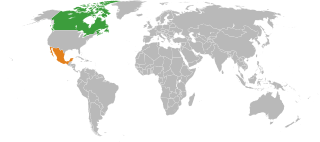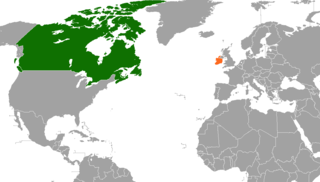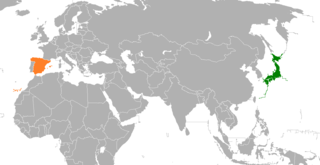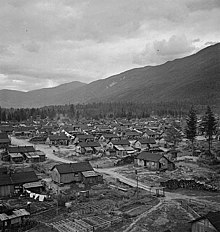
Bilateral relations exist between Australia and Japan.

The relations between Canada and Mexico have evolved over time. Historic ties between the two nations were dormant, but since the 1990s relations between Canada and Mexico have positively developed, as both countries brokered the NAFTA. They were on different sides of the Cold War Spectrum.

Canada and the Republic of Ireland enjoy friendly relations, the importance of which centres on the history of Irish migration to Canada and the two countries' shared history as parts of the British Empire. Approximately 4.5 million Canadians claimed to have Irish ancestors. Both nations are mutual members of the Organisation for Economic Co-operation and Development, United Nations and the World Trade Organization.

Canada–South Korea relations are foreign relations between Canada and the Republic of Korea. Canadian soldiers participated in the defense of South Korea during the Korean War. Full diplomatic relations between Canada and South Korea were established on January 14, 1963. Canada has an embassy in Seoul, and a consulate in Busan. South Korea has an embassy in Ottawa and three Consulates-General, in Montreal, Toronto and Vancouver. Both nations are full members of APEC, OECD and the G20.

Canada–Colombia relations are foreign relations between Canada and the Republic of Colombia. Full direct diplomatic relations were established in 1953, with the exchange of the first ambassadors. Canada has an embassy in Bogotá. Colombia has an embassy in Ottawa and 4 Consulates-General. Both countries are full members of the Organization of American States.

Canada–Chile relations are the diplomatic relations between Canada and Chile. Both nations are members of the Asia-Pacific Economic Cooperation, Cairns Group, Organization of American States and the Organisation for Economic Co-operation and Development.

Canada–Peru relations are the current and historical relations between Canada and the Republic of Peru. Both nations are members of the Asia-Pacific Economic Cooperation, Cairns Group, Lima Group, Organization of American States and the United Nations.

Canada–Italy are the current and historical relations between Canada and Italy. Both nations enjoy friendly relations, the importance of which centres on the history of Italian migration to Canada. Approximately 1.5 million Canadians claim to have Italian ancestry. Both nations are members of the G7, G20, NATO and the Organisation for Economic Co-operation and Development.

Denmark–Mexico relations are the foreign relations between Denmark and Mexico. Both nations are members of the Organisation for Economic Co-operation and Development and the United Nations.

Ireland–Japan relations are the bilateral relations between the Republic of Ireland and Japan. Both nations are members of the Organisation for Economic Co-operation and Development.

Canada–Mongolia relations are foreign relations between Canada and Mongolia. Both countries established diplomatic relations on November 30, 1973. Canada has been represented in Mongolia through an embassy since 2008. Mongolia has an embassy in Ottawa, and in 2002 opened an Honorary Consulate in Toronto. Though Canada and Mongolia established diplomatic ties in 1973, ad hoc linkages and minor activities occurred between the two countries mainly through the Canada-Mongolia Society, which disbanded in 1980. When Mongolia formed a democratic government in 1991 after the collapse of the Soviet Union, Canada began to support Mongolia with donor activities through the International Development Research Centre, Canadian International Development Agency and several non-governmental organizations.

Canada established diplomatic ties with the Kingdom of Thailand in 1961. Canada has an embassy in Bangkok and Thailand has an embassy in Ottawa, as well as consulates general in Toronto, Edmonton, Vancouver and Montreal. Ties between the two countries have consistently been friendly. Both countries are members of the Asia-Pacific Economic Cooperation, and Canada sits on the ASEAN Regional Forum.

Canada–Singapore relations refers to the current and historical relations between Canada and the Republic of Singapore. Both nations are members of the Asia-Pacific Economic Cooperation, Commonwealth of Nations and the United Nations.

Japan–New Zealand relations refers to the diplomatic relations between Japan and New Zealand. Both nations are members of APEC, Australia Group, CPTPP, Organization for Economic Co-operation and Development and the United Nations.

Canada and Portugal have friendly bilateral relations, the importance of which center on the history of Portuguese migration to Canada. Canadians of full or partial Portuguese ancestry number approximately 482,000 people. Both nations are members of NATO, the OECD, and the United Nations.

Canada–Vietnam relations refer to bilateral relations between Canada and the Socialist Republic of Vietnam. Both nations are members of the Asia-Pacific Economic Cooperation, Organisation internationale de la Francophonie and the United Nations.

Japan–Peru relations are the current and historical relations between Japan and Peru. Both nations are members of the Asia-Pacific Economic Cooperation, Comprehensive and Progressive Agreement for Trans-Pacific Partnership and the Forum of East Asia–Latin America Cooperation.

Japan–Spain relations are the bilateral relations between Japan and Spain. Both nations are members of the Organisation for Economic Co-operation and Development.

Chile–Japan relations are the diplomatic relations between Chile and Japan. Both nations are members of the Asia-Pacific Economic Cooperation, Comprehensive and Progressive Agreement for Trans-Pacific Partnership, Forum of East Asia–Latin America Cooperation and the Organisation for Economic Co-operation and Development.

Ecuador–Japan relations are the diplomatic relations between Ecuador and Japan. Both nations are members of the Forum of East Asia–Latin America Cooperation.




























